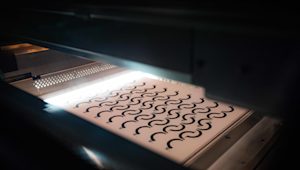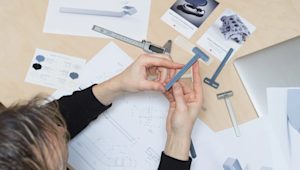The use of 3D printing in manufacturing is on a steady rise, underscoring the transformation of the technology from a hobbyist’s endeavor into a robust industrial solution, with multiple methods and post-processing options providing engineers with a variety of approaches to part creation.
In this article, we’ll explore various methods of 3D printing and post-processing in an industrial context. You’ll emerge with a deeper understanding of each method’s advantages, disadvantages, and commonly used materials, as well as the applications for 3D printed parts that are used in various industries.
What 3D printing methods are commonly used for industrial purposes?
The following methods of 3D printing are often used to create parts meant for industrial use. They are also offered by Protolabs Network.
-
Fused Deposition Modeling (FDM). FDM involves extruding thermoplastic filaments layer by layer, creating robust and cost-effective prototypes and end-use parts, making it versatile for various industries.
-
Stereolithography (SLA). SLA uses a laser to solidify liquid photopolymer resins layer by layer, producing high-detail prototypes and intricate models with smooth surface finishes.
-
Selective Laser Sintering (SLS). SLS fuses powdered materials, like plastics or metals, using a laser, forming strong and complex parts without needing support structures.
-
Multi Jet Fusion (MJF). MJF employs an inkjet array to apply a fusing agent and detailing agent onto powdered materials, resulting in durable and highly precise functional prototypes and end-use parts.
What are the advantages of FDM 3D printing for industrial purposes?
Industrial-grade FDM printing is often used to produce sturdier parts. Additionally, a wide selection of thermoplastic materials allows for the creation of parts that can withstand higher temperatures, making it a versatile option for various industrial applications. Let’s take a closer look.
-
Sturdier parts. FDM allows for the use of a variety of engineering-grade thermoplastics, some of which offer high strength and durability. This is particularly valuable for producing parts that need to withstand mechanical stress, impact, or other demanding conditions.
-
Higher temperatures. The specific temperature resistance of an FDM-printed part depends on the chosen thermoplastic material. Some FDM materials, such as Ultem or PEEK, offer excellent resistance to high temperatures and can be used in applications where heat resistance is critical. However, it is important to note that not all FDM materials are suitable for high-temperature environments, so material selection is crucial.
-
Reduced weight with structural integrity. FDM allows for the creation of lightweight structures within parts while maintaining structural integrity. This is often crucial for industries like aerospace and automotive, where weight reduction is a priority. Engineers can design components with optimized internal lattice structures that reduce overall weight without compromising strength or functionality.
-
Cost-effective, small-batch production. Traditional manufacturing processes often require expensive molds or tooling for production, making small-batch runs economically impractical. However, FDM does not rely on such tooling, and can allow companies to produce small quantities of parts or products without incurring high setup costs. This is particularly advantageous for niche markets or industries that require flexibility in production volumes, such as custom machinery or specialty components.
Materials for industrial FDM 3D printing
Industrial FDM 3D printing employs a range of materials to meet diverse application needs. Common options include engineering-grade thermoplastics (ABS, PLA, PETG), high-performance polymers (such as PEEK and Ultem/PEI), and composite filaments (carbon fiber, glass fiber). These materials offer durability, heat resistance, and mechanical strength suited to industrial applications.
What are the advantages of industrial SLA 3D printing?
Industrial-grade SLA 3D printing offers a range of benefits for high-performance industrial applications, including precision, material versatility, complex geometries, and the ability to meet stringent requirements for heat resistance, chemical resistance, and biocompatibility. Here’s an overview of some of these benefits.
-
Reduced weight with high strength. SLA allows for the creation of lightweight yet robust components by optimizing internal structures. This weight reduction is particularly beneficial in aerospace, automotive, and robotics, where lightweight parts improve fuel efficiency and overall performance.
-
Tolerance and dimensional accuracy: SLA parts can consistently meet tight tolerances and strict dimensional accuracy requirements, ensuring that high-performance components align precisely with specifications and standards.
-
Complex geometries and internal structures. SLA allows for the creation of intricate, high-performance designs, including components with complex internal channels, lattice structures, and customized features. This capability is advantageous in industries like automotive and aerospace, where optimized part geometries can enhance part functionality.
-
High precision and surface finish. SLA excels in producing parts with exceptional dimensional accuracy and smooth surface finishes. This precision is essential for industries such as aerospace and medical devices, where intricate details and fine tolerances are critical for performance.
What materials are used for industrial SLA 3D printing?
Industrial SLA 3D printing utilizes a diverse range of specialized photopolymers and resins. These materials offer versatility in mechanical properties, from rigid and tough to flexible and elastic, making them suitable for applications spanning medical devices, consumer goods, automotive prototypes, and intricate design prototypes with high-resolution finishes.
Additionally, certain SLA resins, such as PEI, exhibit excellent resistance to elevated temperatures. This is crucial for applications involving under-the-hood automotive components and aerospace engine parts.
What are the advantages of SLS 3D printing for industrial purposes?
SLS 3D printing can produce flexible parts with customizable material properties, as well as create thin-walled structures with precision and strength. These capabilities make SLS a valuable choice for industries ranging from consumer goods and medical devices to aerospace and automotive, where lightweight, flexible, and intricate components are essential. Here, we’ll examine a few of these benefits in detail.
-
Complex, thin-walled structures. SLS is capable of producing complex thin-walled structures, including honeycomb designs, which can provide additional strength and stiffness while maintaining a lightweight profile.
-
Conformal cooling channels. SLS is suitable for manufacturing parts with internal features such as conformal cooling channels for injection mold tooling. These channels improve heat transfer efficiency and reduce cycle times in injection molding processes.
-
Customizable material properties. Engineers can adjust the degree of flexibility in SLS-printed parts by modifying the infill density and using lattice structures. This customization makes it possible to create parts with different levels of rigidity and flexibility within a single print job.
-
Rubber-like parts. Some SLS printers support flexible materials that mimic the properties of rubber, ideal for producing gaskets, seals, and components requiring high resilience and elasticity.
Materials for industrial SLS 3D printing
SLS employs a variety of powdered materials tailored to specific applications. For nylon-based SLS, materials like Nylon 12, Nylon 11, and glass-filled nylon offer durability and flexibility, ideal for functional prototypes and consumer goods. Additionally, materials like PEBA can result in parts that are strong, yet exhibit flexible, rubber-like properties.
What are the advantages of MJF for industrial purposes?
MJF is well-suited for high-performance industrial applications due to its precision, material versatility, durability, and ability to create complex, lightweight, and temperature-resistant parts. Here’s a look at how these benefits work in an industrial context.
-
Part consolidation. MJF allows for the integration of multiple components into a single, complex part, reducing assembly requirements, minimizing points of failure, and streamlining the overall design.
-
Customizable material properties. Engineers can tailor the mechanical properties of MJF-printed parts by adjusting infill patterns, densities, and wall thicknesses. This customization allows for the optimization of parts to meet specific performance requirements.
-
Complex geometries. MJF's ability to produce intricate, complex geometries without the need for support structures allows for the design of parts with optimized shapes for improved performance. This is valuable in aerodynamics, fluid dynamics, and other high-performance fields.
-
Lightweight design. MJF enables the creation of lightweight structures within parts, reducing overall weight while maintaining structural integrity. This is particularly important in aerospace and automotive industries, where weight reduction leads to improved fuel efficiency and performance.
Materials for industrial MJF
Multi Jet Fusion (MJF) utilizes a fine powder bed of rigid or flexible thermoplastic material. Rigid plastics include Nylon PA11, Nylon PA12 and PP, while flexible plastics include Estane 3D TPU M95A.
In particular, Nylon's versatility and PA 12's resilience make them suitable for functional prototypes, intricate parts, and low-volume production. On the other hand, Estane 3D TPU M95A is often used to produce parts requiring rubber-like characteristics.
Post-processing for industrial 3D printing
The following post-processing techniques are crucial for enhancing the surface quality, aesthetics, and functionality of industrial-grade 3D-printed parts. They are also offered by Protolabs Network, and used by many of our industrial customers.
-
Vapor smoothing. In vapor smoothing, the 3D-printed part is exposed to a controlled atmosphere saturated with a specific solvent vapor. The vapor partially melts the outer layer of the part, smoothing out layer lines and surface imperfections. Vapor smoothing is particularly effective for parts printed with materials like ABS and ASA.
Bead blasting. Bead blasting involves propelling tiny abrasive particles (such as glass beads or ceramic beads) at high speed against the surface of the part. This process removes surface imperfections, roughness, and support structures, resulting in a smoother and more uniform finish. Bead blasting is suitable for metal and plastic parts.
Manufacture industrial 3D printed parts
Get an instant quote for your 3D printed custom parts using our online quote builder.
For further reading, you can find out more about 3D printing capabilities and materials, or gain more expertise about additive manufacturing by exploring our Knowledge Base.
Frequently asked questions
How has 3D printing evolved into an industrial solution?
3D printing has transitioned from hobbyist use to industrial use due to improved materials, precision, and the ability to meet stringent performance standards.
How does 3D printing support lightweight design in industrial applications?
It allows for the creation of intricate internal structures, reducing weight without sacrificing strength.
How does 3D printing support flexible designs in industrial applications?
3D printing supports flexible designs in industrial applications by allowing for the creation of intricate internal structures and customized infill patterns, optimizing parts for specific flexibility requirements.
Why is precision crucial in industrial 3D printing?
Precision ensures parts meet strict tolerances and industry standards, making them reliable for high-performance applications.
What advantages does industrial 3D printing offer over traditional manufacturing methods?
The benefits of industrial 3D printing include rapid prototyping, lightweight design, and cost-effective small-batch production.
Which post-processing techniques are essential for achieving industrial-grade quality?
Vapor smoothing, bead blasting, and surface coating are crucial for improving part finish and functionality.



















